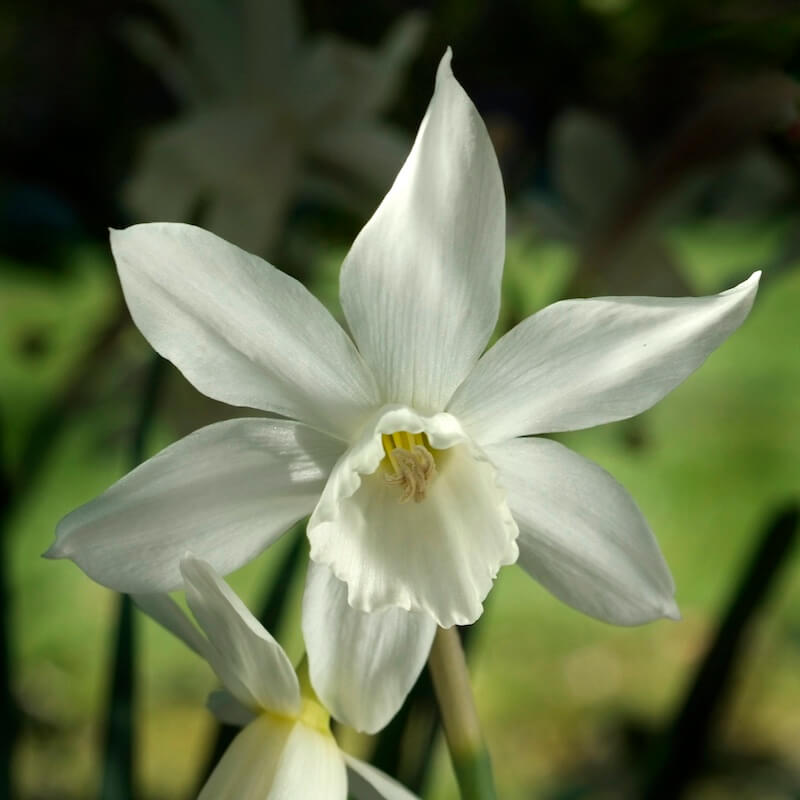
Position
- Full sun to light shade; full sun gives the best flowering
- Prefers a sheltered spot protected from strong, drying winds
- Ideal in mixed borders, rockeries, containers or naturalised in grass
Hardiness
- Tolerates winter lows down to around –20 °C (–4 °F)
- A light autumn mulch over the bulb bed aids establishment in very exposed gardens
Soil
- Thrives in fertile, well-drained soils such as loam or sandy loam
- Benefits from soil improvement at planting with garden compost or well-rotted manure
- Avoids heavy, waterlogged clay which can cause bulb rot
- Adaptable to acid, neutral or alkaline soils
- Performs best where organic matter maintains good structure and moisture without waterlogging
- Grab a soil test kit and ensure the perfect conditions for growth
Height
- Clumps mature to around 30–40 cm (12–16 in) tall each spring
Seasons of Interest
Additional Notes
- Plant bulbs in autumn, 12 cm deep and 10 cm apart, in groups or drifts for best impact
- Leave foliage until fully yellow before cutting back to allow bulbs to replenish energy
- Divide and replant congested clumps every 3–4 years once leaves have died down
- Dead-head spent flowers to keep the display tidy and direct energy back into the bulb
- All parts are mildly toxic; handle bulbs with gloves and keep away from pets and children
- Excellent for naturalising in grass—lift and replace turf after flowering to avoid damage
Narcissus Thalia - The Fragrant, Pure White Narcissus
Discover the refined charm of Narcissus Thalia, a triandrus daffodil celebrated for its graceful, nodding white flowers. This special daffodil bulb offers a serene but cheerful presence in spring, bringing sophistication and gentle fragrance to gardens and containers alike. Gardening enthusiasts adore it for its dependable returns year after year and its ability to elevate a bulb display with subtle style. This article will guide you through everything from planting to post-bloom care, helping you grow narcissus, enjoy blooms, and build a standout collection of flower bulbs.
What Is Narcissus Thalia, and Why It Delights
Narcissus Thalia belongs to the triandrus group of narcissus spp, prized for its elegant, nodding white flowers. Often called the pure white narcissus, it carries that timeless, quiet beauty gardeners love. Each stem may have two or more nodding flowers per stem, giving a graceful cluster rather than a single trumpet. Its petals or perianth segments often reflex slightly, giving a refined classic shape.
The daffodil bulb itself is moderate in size among narcissus types. While many daffodils aim for bold spectacle, the narcissus thalia provides relaxed charm that blends beautifully with other spring bloomers. The fragrance is light but distinctive, making it a fine choice for cutting or growing near paths and seating. It suits gardeners who appreciate subtlety alongside reliable bloom.
Thalia bulbs tend to naturalise quite well. Over time, they create drifts of soft white that glow gently in early spring. They seldom demand heavy maintenance and often bloom year after year with minimal intervention. That kind of ease and grace makes them a favourite among those who love daffodil bulbs and refined spring displays.
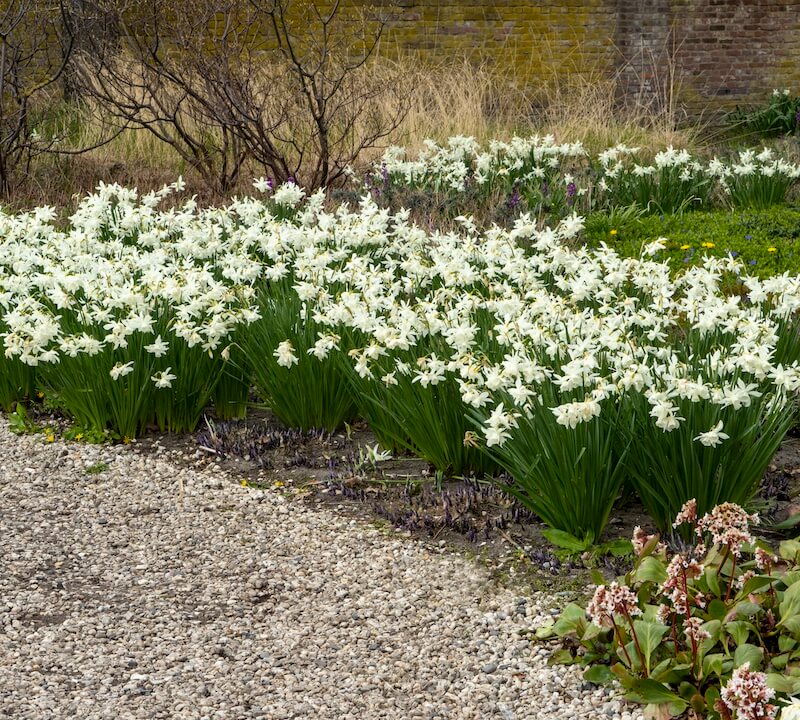
When to Plant Thalia Bulbs for Best Results
Timing matters when you plant daffodil bulbs. For Narcissus Thalia, you should plant in autumn, when the soil is still warm enough to stimulate root growth but air temperatures begin to drop. In many parts of the UK, this period is between late September and November, before the ground hardens or becomes waterlogged.
If your region cools early, aim to plant by mid-October so the bulbs establish before winter. If you live in the temperate areas where winters are mild, you might grow a little later, but always avoid planting in frozen or excessively wet soil. The goal is for the bulbs to form strong roots ahead of frost and dormancy.
Planting too late can hamper root development and reduce flowering vigour. Planting too early doesn’t cause much harm, but prolonged exposure before dormancy can stress the bulb. So monitor soil temperature: around 10–12 °C (50–54 °F) or lower is often ideal for root initiation.
How Deep and Where Should You Plant the Bulb?
Correct depth and placement influence how well your bulbs thrive. For Narcissus Thalia, plant the bulb at a depth roughly two to three times its height. That typically means 7–10 cm or even 10–12 cm, depending on bulb size. Place the pointy tip uppermost and cover with soil.
Space bulbs at least 5 cm to 10 cm apart so they don’t crowd out each other as offsets form. In heavier soils, lift a little soil before planting and mix in grit to improve drainage. You want roots to spread but avoid rotting.
Choose a location with good light—full sun or partial shade works well. Avoid planting in deep shade. Also, avoid soggy ground in winter; well-drained soil is essential. This placement ensures your flowers emerge clean and upright without flopping.
Can You Grow Narcissus Thalia in Pots or Containers?
You can definitely grow Narcissus Thalia in pots and containers, making it an excellent choice for patios, balconies, or small gardens. The daffodil bulbs adapt neatly to container conditions if you follow some key steps.
Use a pot at least 20 cm deep, with drainage holes. Fill with a mix of good-quality potting compost and grit for drainage. Plant the bulbs in clusters rather than single specimens so they support each other. Arrange with pointy tips upward.
Water well after planting, then place the pot in a sheltered, cool spot until growth appears. When shoots appear, move them into bright light so the stems grow sturdy. The flower display will reward you beautifully. After the bloom cycle, allow foliage to fade naturally in the pot before lifting or storing the bulbs.
Growing in containers gives flexibility. You can move the pot, group it with other containers, or place it near a doorway to enjoy the fragrance. It’s a lovely way to include narcissus thalia in smaller, urban garden settings.
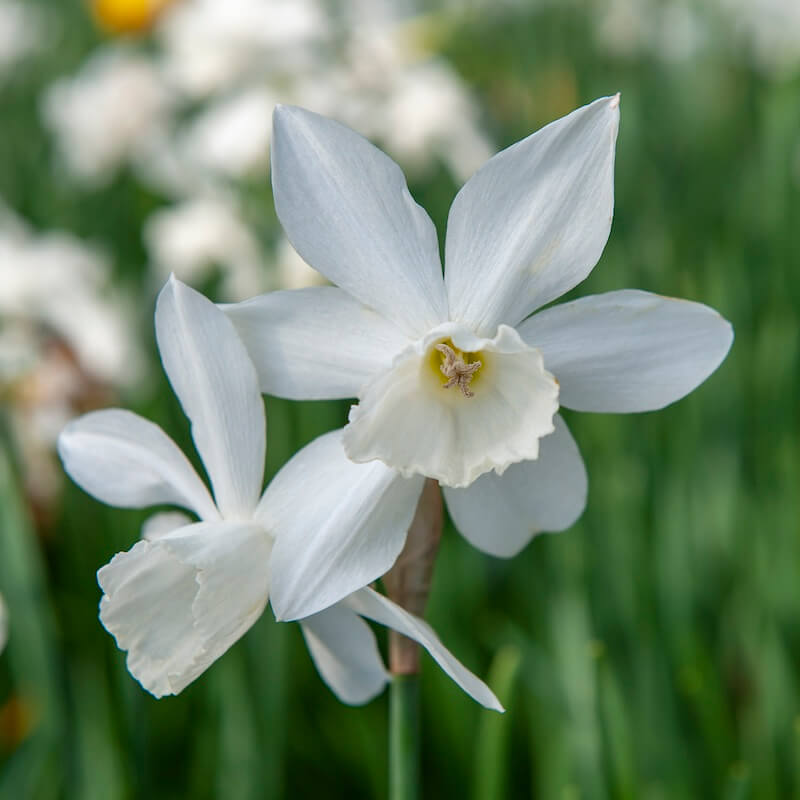
How to Care for the Flower and Leaves After Bloom
Once your Narcissus Thalia flowers fade, avoid cutting foliage prematurely. Let the stems and leaves stay until they turn yellow and wither. During that time, they feed the bulb, storing energy for the next season.
Remove spent blooms by deadheading. Snip off the faded cup or group of petals rather than tearing foliage. That ensures the bulb’s resources go into bulb health and next year’s growth.
Maintain moderate moisture while the leaves are active. Do not overwater, especially once foliage begins to die back. As the leaves fade and dry, reduce watering gradually. When the foliage fully dies, you can cut it away neatly. Then the bulb enters dormancy until next autumn.
If you grow in containers, you might lift the bulbs after foliage disappears and store them dry until replanting. But for a less disturbed approach, leave them in situ and allow them to naturalise.
Should You Naturalise Thalia in Borders or Lawn?
Many gardeners let their Narcissus Thalia naturalise in borders or lawn areas. Over time, the bulbs multiply and create soft, glowing patches of white in spring. That relaxed drift effect brings a gentle charm to woodland or mixed borders.
For naturalising, scatter bulbs in drifts rather than straight rows. Plant them among spring companions like muscari or early crocus. Their subtle white flowers layer beautifully with pale blues or purples, allowing stronger-coloured bulbs to take centre stage.
In lawn areas, plant clumps where the grass is thin. After growth finishes, grass will cover the foliage over the summer. Some gardeners lift clumps every few years to maintain vigour, especially where soil becomes compacted. But many gardeners find narcissus bulbs like Thalia thrive with minimal disturbance.
Naturalising gives long-term returns with a low-maintenance spring display that delights year after year.
How to Combine Thalia with Other Spring Bulbs
To create a charming spring display, mix Narcissus Thalia with other daffodil bulbs and early bloomers. Try pairing with triandrus daffodil types or low-growing crocus to create contrasting height and colour. The soft white of thalia, offset by blues or violets, creates a refined harmony.
You might also plant with spring tulips or small hyacinth varieties. Use thalia in the foreground or middle of beds so its nodding white flowers don’t get hidden by taller companions—group bulbs in odd numbers—3, 5 or 7—for a natural impression.
In containers, mix thalia bulbs with muscari or small tulips. The result is layered and interesting. The nodding, white flowers per stem of thalia bring gentle movement, while companions provide bursts of colour.
Balance and contrast matter. Use leaf texture differences and bloom times to sustain interest. Thalia often blooms in March and April, so stage your planting mix to give continuous spring colour without crowding.
What Soil, Light, and Conditions Suit Thalia Best?
Narcissus bulbs benefit from well-drained soil; Thalia is no exception. In clay or heavy soil, mix in grit or sharp sand to improve drainage. They dislike sitting in wet conditions over winter, which can cause rot.
These bulbs prefer full sun or partial shade. They bloom best if they receive several hours of sunlight in spring before deciduous trees leaf out. Avoid deep shade or woodland corners where light is too low.
Soil fertility should be moderate rather than rich. Enrich the bed lightly with compost before planting, but avoid overfeeding, especially nitrogen, which may encourage foliage rather than bloom. Good root development matters more than heavy feeding.
If your site is windy, plant where stems get some protection; Thalia has delicate stems and nodding flowers that may suffer in strong winds. A sheltered border edge or planting behind low shrubs often works well.
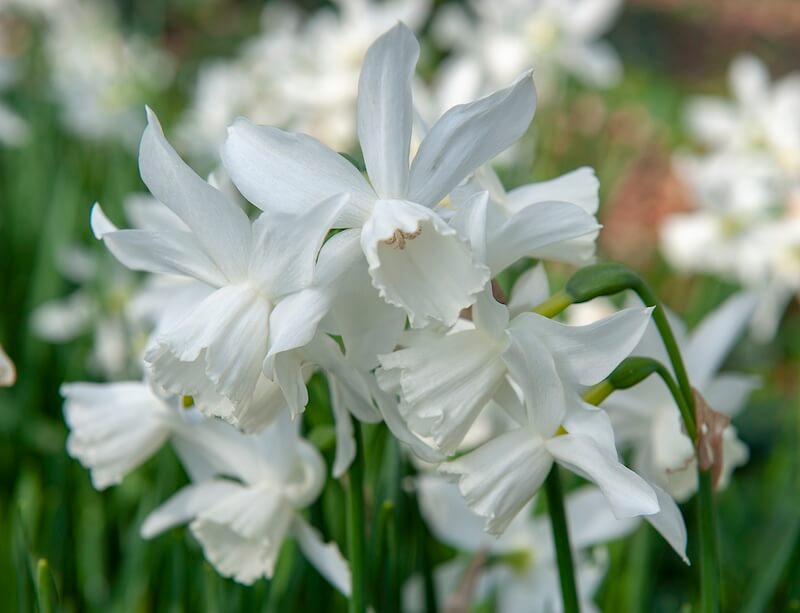
What to Do When Daffodil Bulbs Are Delivered
When daffodil bulbs are delivered, check their condition immediately. Choose bulbs that feel firm, free from soft spots, mould or shrivelling. Discard any damaged specimens.
If you cannot plant right away, store them in a cool, dry, well-ventilated place—ideally around 15 °C (59 °F). Avoid sealed plastic that traps moisture and heat. Keep them out of sunlight and away from strong heat sources.
If some bulbs show signs of early sprouting or small root growth, aim to plant them soon. Handle gently, avoid disturbing emerging roots, and plant at the correct depth. Water in lightly to help soil settle around the bulbs.
Once planted, nature takes over. Over winter, bulbs settle in, and by the following spring, they rise with fresh green shoots and soon white nodding blooms.
How to Multiply or Divide Narcissus Bulbs
After several seasons, your narcissus bulbs produce offsets—small bulbs attached to the parent. To maintain vigour, lift and divide them every 3 to 5 years after foliage has died back.
Gently dig the clump, shake off soil, and separate the smaller bulbs from the main ones. Handle carefully so you don’t damage roots. Replant each offset at the appropriate depth and spacing.
These newer bulbs may take a year or two to flower fully. But over time, they mature and replenish your stock. This division process is the gardener’s way to maintain bloom strength and expand your collection sustainably.
Regular division prevents overcrowding and ensures that next year’s growth stays strong. It also helps maintain airflow and soil health in your bed.
From Darren’s Patch
There’s something genuinely soothing about Narcissus Thalia. I may not have it in my borders right now, but I’ve grown it many times before — and it never disappoints. What I love most is its quiet confidence; it doesn’t shout for attention like the bolder trumpet daffodils, yet it still manages to steal the show when planted in groups. The pure white blooms nod gracefully in the breeze, catching the light in that lovely, understated way that makes spring mornings feel fresh and hopeful. Whether you’re filling pots near a doorway or naturalising them through the lawn, Thalia is one of those daffodils that rewards you with poise and purity year after year — a true garden classic that feels effortlessly elegant in any setting.
![]()
Key Points to Remember
- Narcissus Thalia is a refined triandrus daffodil producing graceful white flowers
- Plant daffodil bulbs in autumn, ideally between September and November
- Aim for about 7–10 cm depth, spacing bulbs 5–10 cm apart
- Suitable for planting in pots or containers as well as open borders
- After blooming, deadhead the flowers but allow the foliage to die back naturally
- Naturalise Thalia in borders or lawn for a lasting, low-maintenance display
- Mix thalia with early bloomers like crocus, muscari or small daffodil bulbs for contrast
- Use well-drained soil, moderate fertility, and good light to support bloom
- When bulbs are delivered, inspect and store or plant promptly
- Divide bulbs every few years to maintain vigour and multiply your stock
Narcissus Thalia is one of the most graceful triandrus daffodil cultivars you can grow – timeless, elegant, and effortlessly reliable. Whether you choose to plant them in swathes across lawns, nestle them in containers, or pair them with other flower bulbs like muscari and tulipa, they’ll add a touch of classic charm that brightens every spring. With minimal effort and simple feeding, these bulbs reward you year after year with their serene beauty. So why wait? Choose Thalia bulbs this season and watch your garden come alive with radiant, pure white narcissus blooms.
Would you like to learn about other bulb varieties? Read about Narcissus Toto here.
For more information on Spring Flowering Bulbs for your garden, please click here.
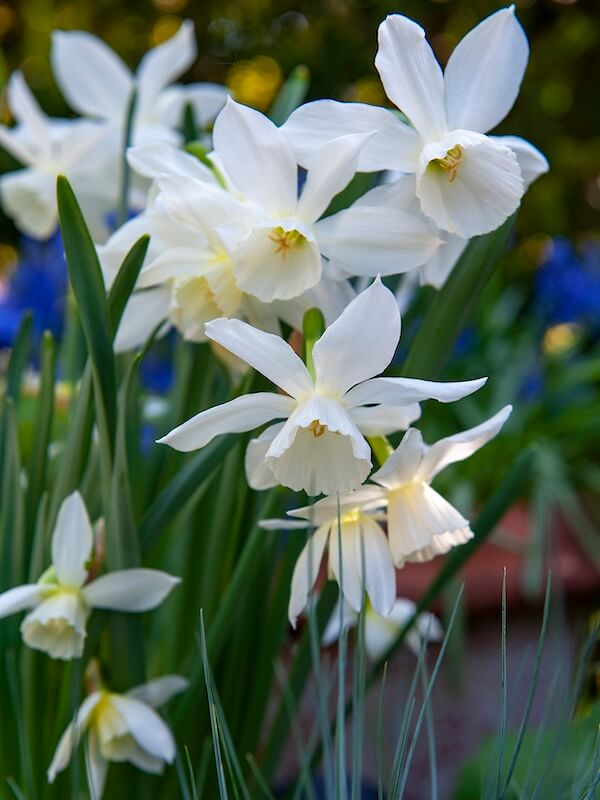
Frequently Asked Questions
Q: What is Narcissus Thalia, and why is it so special?
A: Narcissus Thalia, often known as the triandrus daffodil, is a pure white narcissus with elegant, nodding flowers per stem and a graceful, reflexed perianth. Classified as Division 5, this perennial belongs to the group sometimes called orchid narcissus due to its delicate, orchid-like appearance. ‘Thalia’ looks fabulous planted in swathes, naturalised through borders or lawns, or mixed with tulipa and muscari for a soft, romantic spring display. Its fragrant, pure white flowers bloom beautifully through March and April, brightening any garden year after year.
Q: When is the best time to plant Narcissus Thalia bulbs?
A: The ideal time to plant the bulbs is in autumn, from September to early November, before the first frost sets in. Plant Narcissus Thalia bulbs approximately 10cm deep and 10cm apart, with their pointy tips uppermost. They thrive best in moderately fertile, well-drained soil that remains moist but not waterlogged. To establish strong roots, ensure the soil is worked well and enriched with a bit of good-quality potting compost if needed. Thalia bulbs grow well in pots, borders, or even grassy areas where they can naturalise and multiply year after year.
Q: What type of soil and location does Narcissus Thalia prefer?
A: Narcissus Thalia bulbs perform best in a moderately fertile, well-drained soil and a sunny or partially shaded position. They tolerate light shade, but to maximise flowering, ensure they receive at least half a day of sunlight. Avoid overly wet spots, as bulbs can rot if left in standing water. Thalia’s relaxed habit enables it to sit comfortably in mixed plantings with tulipa, muscari, or hyacinth, adding a touch of effortless charm to borders or lawns. Its pure white flowers stand out beautifully against green foliage, creating a serene, timeless spring scene.
Q: How tall does Narcissus Thalia grow, and what does it look like in bloom?
A: Narcissus Thalia grows to a graceful height of around 35–40cm tall. Each tall stem typically produces two or sometimes three nodding flowers per stem, with reflexed perianth segments that surround the corolla in a classic triandrus shape. Its blooms are pure white, often referred to as white splendour, and have a subtle, fragrant scent. The elegant flowers last about a week in a vase once cut, making them a perfect addition to spring arrangements. These white-flowering daffodils add lightness and grace, complementing colourful tulip and grape hyacinth displays.
Q: How should I feed and care for Narcissus Thalia after flowering?
A: Once the flowers have faded, deadhead each bloom by removing the stems and leaves only after they’ve yellowed naturally. This allows the bulb to draw in nutrients for next year’s growth. Feed with a balanced bulb feed or a general-purpose garden feed after flowering to replenish energy. Keep the area well watered for a few weeks to support root health. Avoid cutting back foliage prematurely, as it helps sustain strong roots. With proper post-flowering care, your Thalia bulbs will return with renewed vigour and more blooms year after year.
Q: Can Narcissus Thalia be grown in pots or containers?
A: Absolutely! Narcissus Thalia grows well in pots, making it ideal for patios, balconies, or front door displays. Use a good-quality potting compost and ensure containers have proper drainage. Plant the bulbs 10cm deep with their pointy tips uppermost and space them closely for a full display. Water moderately and feed lightly during the growing season. Once flowering finishes, let the foliage die back naturally. Try planting alongside hyacinth, muscari, or tulipa to create a fresh spring composition that resembles a designer bulb collection straight from the RHS show gardens.
Q: Are Narcissus Thalia bulbs harmful if eaten?
A: Yes. Like all narcissus spp, Thalia bulbs and plant parts are harmful if eaten. They contain natural compounds that can cause stomach upset or skin irritation. Always wear gloves when handling bulbs and keep them away from children and pets. Despite this, they remain one of the most rewarding flower bulbs to grow, loved for their beauty and ease of care. Their ease of identification and reliability make them a gardener’s one-off seasonal treat that brings effortless charm to any setting.
Q: Where can I buy Triandrus Daffodil bulbs, Narcissus Thalia?
A: You can buy triandrus daffodil bulbs, Narcissus Thalia, at most reputable garden centres, RHS plant shops, and online bulb specialists across the UK. Look for suppliers offering bulbs available from late summer through autumn for the best planting window. When purchasing, select firm, healthy bulbs free from mould or soft spots. Many retailers also provide dainty daffodil collections, including narcissus varieties like White Prince and White Splendour, for a diverse spring display. Whether you’re a beginner or seasoned gardener, these bulbs promise a pure white narcissus show that’s both reliable and captivating.
Q: Can Narcissus Thalia be combined with other spring bulbs?
A: Definitely! Narcissus Thalia pairs beautifully with other spring flower bulbs, particularly tulips, muscari, and hyacinths. This combination adds layers of texture, colour, and fragrance to the garden. The relaxed habit enables Thalia to mingle naturally, softening the edges of beds and borders. Try planting them in drifts or mixed pots to create a fresh, painterly effect. For added interest, blend Thalia bulbs among orchid narcissus or sometimes orchid daffodils, offering continuity of bloom and fragrance. These harmonious plantings deliver an elegant, favourite white-flowering daffodil display that feels effortlessly curated.
Q: How can I ensure my Narcissus Thalia bulbs thrive year after year?
A: After planting, ensure bulbs receive enough moisture during the growing season and are kept well watered during dry spells. Apply a moderate feed after flowering to encourage strong roots and bulb division. If clumps become crowded, lift and divide them every 3–4 years in summer once the foliage dies back—Replant immediately for next year’s growth. Avoid waterlogged soil, as bulbs need good drainage to avoid rot. Following this planting information ensures your Narcissus Thalia continues to perform beautifully, gracing your garden with pure white flowers each March and April without fail.
